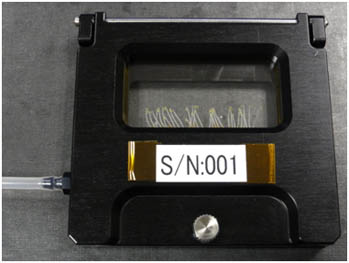This is an archive of information released in the past.
Disclaimer: It may contain broken links or outdated information. Some parts may not function in current web browsers.
*Visit https://humans-in-space.jaxa.jp/en/ for the latest information.

Experiment
- News
- Kibo Utilization Strategy
- Kibo Utilization Plan
- List of JAXA's Utilization Themes
- Experiment Facilities
- Space Environment Utilization
- Archive
A life science experiment "Aniso Tubule" (first session) was conducted on board Kibo
A life science experiment "Aniso Tubule*" (first session) was conducted on board the Japanese Experiment Module "Kibo."
*Roles of cortical microtubules and microtubule-associated proteins in gravity-induced growth modification of plant stems
Principal Investigator (PI): Kouichi Soga, Osaka City University
Aniso Tubule experiment seeks to understand the mechanisms of how plants build their shape while resisting gravity, focusing on the structure of "cortical microtubules" that determines the growth direction of plant cells.
The experiment germinated thale-cress (Arabidopsis hypocotyls) with Green Fluorescent Protein (GFP)-fused tubulins and cultivated for three days.
Then, stem cell shapes and cortical microtubules of the thale-cress were analyzed from the ground with a fluorescence microscope in Kibo. The session (germination, cultivation, and observation) will be conducted ten times under the same condition to obtain data of cortical microtubules and cell structures.
If the mechanism of how plants grow upward against gravity is understood by this experiment, plant's shape or the growth direction can be controlled. If applied, effective plant cultivation in a narrow and specific spot as well as in space in the future might be possible.
- Launch: Sample chambers containing the seeds of thale-cress were carried to ISS Kibo aboard H-II Transfer Vehicle KOUNOTORI4 (HTV4), which was launched from the Tanegashima Space Center (TNSC) on August 4, 2013.
- Experiment start: On November 18, JAXA Astronaut Koichi Wakata injected water in a chamber and stored it at low temperature in the Minus Eighty degree Celsius Laboratory Freezer for ISS (MELFI) on Kibo at 5:19pm, on the same day.
- Germination start: 4 days after the water injection, the chamber was removed from the MELFI, and the seeds were exposed to light. At 3:24 am on November 23, the germination was started as the chamber was set in the Cell Biology Experiment Facility (CBEF) at a temperature of 21.5℃.
- Preparation for the observation: Thale-cress grew smoothly in the dark. After three days of the cultivation, the chamber was set to microscope by astronaut Wakata on November 26, 3:37 am.
- Observation: Observation of the thale-cress stems using a fluorescence microscope was successfully done by control from the User Operation Area (UOA) in the Tsukuba Space Center. The session will be conducted 10 times.

In front of the Fluorescence Microscope (upper left) installed on Kibo, Astronaut Wakata poses for a photo before setting the sample chamber (floating below his face). (Credit: JAXA/NASA)
This research theme was selected as one of the additional utilization themes of Kibo PM's second phase utilization period.
Abstract: Aniso Tubule [PDF: 8KB]

A sample chamber used to grow plants and for observation
(photo taken on orbit, credit: JAXA/NASA)

Photo of a sample chamber taken on the ground
(Credit: JAXA)
*All times are Japan Standard Time (JST)
| Copyright 2007 Japan Aerospace Exploration Agency | Site Policy |